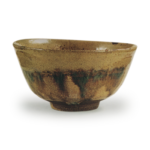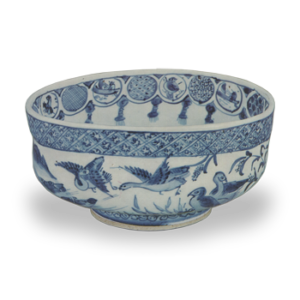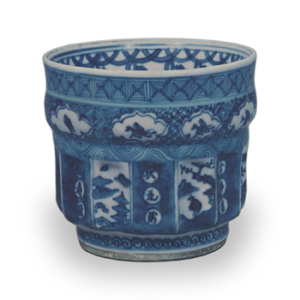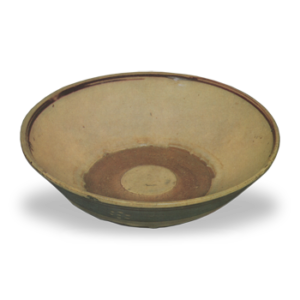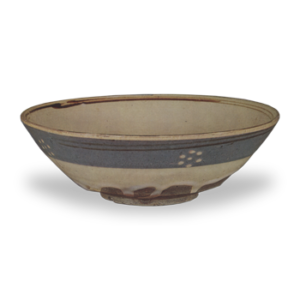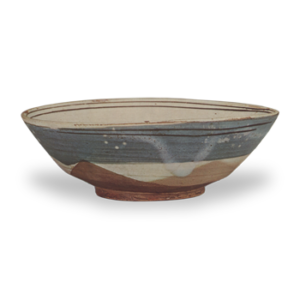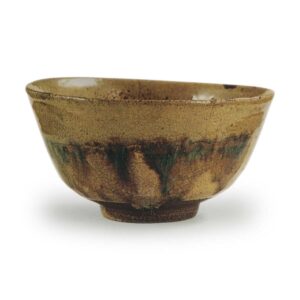
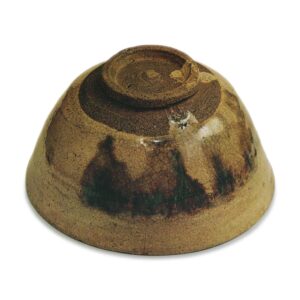
Height: 7.5-8.3cm
Diameter: 14.3-15.0cm
Foot diameter: 5.8cm
Height: 0.8cm
In the Taisho Meiki Kan (A Guide to Famous Tea Utensils of the Taisho Period), there is a reference to a tea master called Kaifuya Sosen who lived in Sakai in the olden days and who owned a famous bowl for grinding powdered tea. It is thought that this Haku-an bowl may have belonged to Sosen. However, it is not clear what kind of tea master Sosen was. The book also introduces several other famous Hakuans, but this Sosei Hakuan is thought to be the closest in shape and appearance to the original Sekido family Hakuan.
First of all, the clay is a light grayish-white with a hint of yellowish tinge, and it is somewhat hard and tightly fired. The foot ring is carved out and drawn neatly on a fast potter’s wheel, and is a well-tightened bamboo joint foot ring, and the carving marks next to the foot ring are also clear. The foot ring of Haku-an is usually promised to be a crescent-shaped thin ring, but it is not a thin ring, but almost a correct ring.
The potter’s wheel was turned at a slightly fast speed, and the marks left by the wheel are pleasant and run up the surface of the vessel at a right angle, and there are some fairly clear cracks in the clay. The rim is slightly bulging, showing a slight distortion, and it is a little more rounded than usual. As a result, it looks somewhat flatter than the usual Haku-an. The inside is capacious, and the large lathe marks are particularly striking. It is worth noting that the cracks on the outside of the piece match some of the marks made by the potter’s wheel, and it is thought that these horizontal cracks were caused by an imbalance of internal and external pressure during the molding process. In other words, it can be said that these cracks were created by the potter’s habit of making marks like this on the wheel.
The glaze is a transparent, glossy yellowish-brown called Kise-do glaze, and the foot ring glaze is also about as expected. The glaze has large and small cracks all over, and the color is only slightly tinged with loquat, and is generally very similar to the yellowish-brown Kise-do glaze of the Muromachi period. In particular, the part of the tea-drip well is thickly glazed, and the subdued green color is beautiful. And as promised, from the crack in the outer one-character pattern, a brownish-red glaze of the namuhi type flows down in a curtain-like pattern with light and dark patches. This is to prevent the crack from breaking in the kiln . This method of glazing and firing was used to prevent the ware from breaking at the cracks in the kiln, and a similar method was often used by Joseon Dynasty potters.
According to the Taisho Meiki Kan (A Guide to Famous Artifacts of the Taisho Period), it was first owned by Soetsu, then passed to either Tsuchiya Sagami no Kami or Daimonjiya Soeki, and from the Bunsei era (1818-1830) it was in the possession of the Mizoguchi family, but in around 1901 it was passed to Takahashi Taian, and in around 1920 it was passed to the current owner.
In addition, the “Toto Chakai Ki” (Record of a Tea Gathering in the Eastern Capital) tells us that when Inoue Seigai invited 15 guests from Kanazawa to Uchida Mountain in October 1913, he produced a luxurious version of the tea ceremony by serving two bowls of tea, one from the original Haku-an bowl and the other from the Sosei Haku-an bowl, and astonished the tea masters of Kaga. This is a clear indication that Sosen is a famous bowl that can be compared to the original.
There are no accessories worth mentioning.

